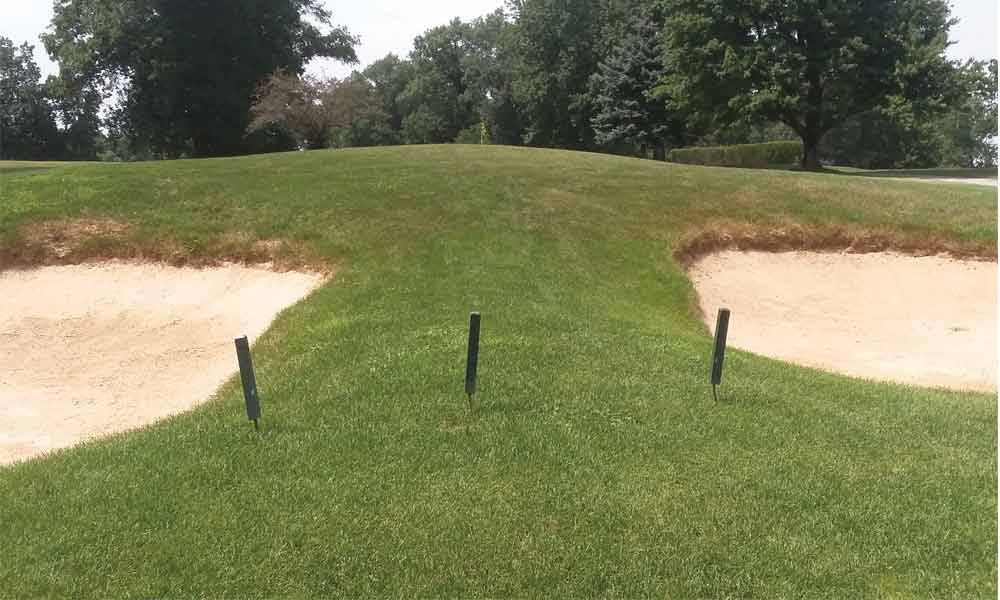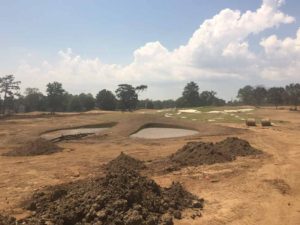

Principal's Nose bunker(s) are on the 16th hole at St. Andrew's
It’s one of the most indelible and endearing architectural features in golf: the Principal’s Nose bunker, a three-dimensional hazard designed to resemble the aquiline proboscis of the sternest schoolmaster you ever survived. But a Principal’s Nose bunker is much more than just a formidable-looking aesthetic. Properly positioned on a golf hole, it’s a brilliant and versatile design feature that creates a wide variety of strategic options.
“The original Principal’s Nose bunker(s) are on the 16th hole at St. Andrew’s. They are positioned on a mound which appears as a nose and the two bunkers are the nostrils,” explains golf course architect Stephen Kay. “This how the ‘twin bunkers’ that make up the Principal’s Nose has been designed and placed on many golf courses.” And with that, a legend was born. Golfers were enamored with the tongue-in-cheek name as well as the fearsome hazard, and so the Principal’s Nose entered into golf lore.


After acquiring iconic status at St. Andrews for its originality, humor, and strategic positioning, the Principal’s Nose came into vogue in America when Golden Age golf architect Charles Blair Macdonald built one at the 11th hole at National Golf Links of America. Macdonald, along with his architectural bloodline of Seth Raynor and Charles “Steamshovel” Banks then built versions of a Principal’s Nose at many courses around the country, including Lookout Mountain, Yale, and St. Louis Country Club to name a few.
Pundits opinions are split as to exactly how strategic the versions built by the Bloodline are. Some are considered more aesthetic than strategic, yeaman’s Hall, for example, where the Principal’s Nose was more an aiming bunker in the distance than a strategic hazard. Other versions are the quintessential example of the intended architectural purpose. But most architects and critics agree: the best Principal’s Nose bunkers are positioned in the middle of a fairway, exactly where you would want your shot to land – either the tee shot on a par-4 or a second shot on a par-5.
“The idea is you have to play short of it, go over it, or play to either side. It adds instant strategy,” wrote now deceased golf architect George Bahto. He further explained that the wider side should have a worse angle to the green than the narrower side so that the golfer has to challenge the hazard in order to have an easier second shot. As a result, properly positioned, a Principal’s Nose bunker complex tests both distance control and accuracy.
“Remember, it’s a three-dimensional hazard, so a prototypical Principal’s Nose is built by first building or finding a mound anywhere between four to seven feet high. [Then] add the two bunkers – one front left and one front right. The sand can be flat or can be flashed up high depending upon how hard the designer wants the shot out of the bunkers to be,” continued Kay, who recently built a well-received Principal’s Nose bunker at East Orange Country Club’s short par-4 16th hole.
“Remember a bunker is basically a bathtub so the bottom should be a minimum of 18″ below the front edge of each bunker. And depending upon whether your sand will be flat or be flashed up will dictate how high you edge the side of the bunker closest to the high point of the mound.”
Most common arrangement of the mound and bunkers
While Kay describes the most common arrangement of the mound and bunkers, several other versions have come into vogue as well. Sleepy Hollow Country Club, currently undergoing a stratospherically good restoration/renovation by Gil Hanse, has a Principal’s Nose at the par-5 sixth hole where the bunkers wrap around bulbous mound, forming a circle around it. Positioned slightly too far to the right of the fairway, the Principal’s Nose at Sleepy Hollow doesn’t quite come into play as often as at other courses, leading some writers like Bahto to describe the use of it by Macdonald in this instance as more cosmetic. Still, architects and superintendents gladly make the pilgrimage to Sleepy Hollow to see Hanse’s brilliant resurrection of Macdonald’s design concepts.
“I have always thought that adaptations of the Principal’s Nose bunkers were one of the best ways to create a centerline hazard on a hole where I could dictate play by making the player make a decision on distance control or angle of attack for the second shot,” explained Lester George, a current board member of the American Society of Golf Course Architects and the designer of Ballyhack Golf Club and Kinloch Golf Club, widely regarded as two instant classics and modern masterpieces. George is currently designing two Principal’s Nose bunkers – one at Vestavia Country Club in Birmingham, Alabama and the other at the Hill Golf Course in Blacksburg, Virginia.
“At the Hill, one of my renovation projects, on the par-4 ninth hole the risk-taker can play to a tighter right side of the uphill fairway to get a better angle into the green. Playing to the left of the Principals Nose on this hole is an easier tee shot, but leaves a harder second shot into the green,” he explained. “At Vestavia, I am building a riveted sod wall version which not only makes the player choose a side of the fairway, but also creates a visual optical illusion making the green appear much closer than it really is.”
George is being modest, because he’s actually best known for his addition of a Principal’s Nose bunker at the 10th hole of the Old White Course at the Greenbriar Resort in White Sulpher Springs west Virginia. This example was listed by Golf Digest Magazines Ron Whitten as one of the 10 Best Bunkers in America. His version at Vestavia reportedly resembles the one at Old White in both aesthetics and strategies.
Sadly, such additions don’t always prove popular. No less a personage than Tom Doak himself, the genius who designed Ballyneal, Pacific Dunes, and The Loop, a reversible course in Michigan, had one of his Principal’s Nose bunkers removed by a membership. In the summer of 1986 and with the approval of the project chairman, Woody Millen, Doak built a Principal’s Nose bunker in the middle of the 10th fairway at Piping Rock Club. What Doak didn’t realize was that most of the members at Piping Rock viewed the tenth hole as a “breather” hole after the particularly tough stretch of holes7-9.
Happily, as the Second Golden Age of Golf Course Architecture progresses, more clubs are expanding their architectural horizons and embracing what was once wrongfully decried as “too quirky.”
“That’ what we need more of, though,” explains golf design expert Pat Mucci. “6,500-yard courses with great green contours, undulating fairways, and cool strategic features. It’s the way forward in golf.”
Recent Posts
Memphis Country Club: A Golfer’s Study in Precision and Tradition
If you have ever teed it up at Memphis Country Club, you know this isn’t…
Foley Company attains GCSAA Silver Partner Status
Foley Company, a leader in turf equipment innovation and technology, affirms its support of the…
Harrell’s continues longstanding support of the GCSAA Foundation
Harrell’s LLC, a leading distributor of customized agronomic products for turfgrass since 1941, has donated…
City of Orlando Announces New State-of-the-Art Driving Range at Dubsdread Golf Course
The City of Orlando is excited to announce the construction of a brand-new, state-of-the-art driving…
Discover Puerto Rico for Great Golf Trips and After-Round Activities, Amenities
Golfers cannot live by the game alone which is why Puerto Rico provides the perfect…
Q&A with a Multi-talented Golf Course Architect – Part 2: Making the Rounds – Installment 39
This column features recollections of the author’s 37 years as a golf writer. These installments…


